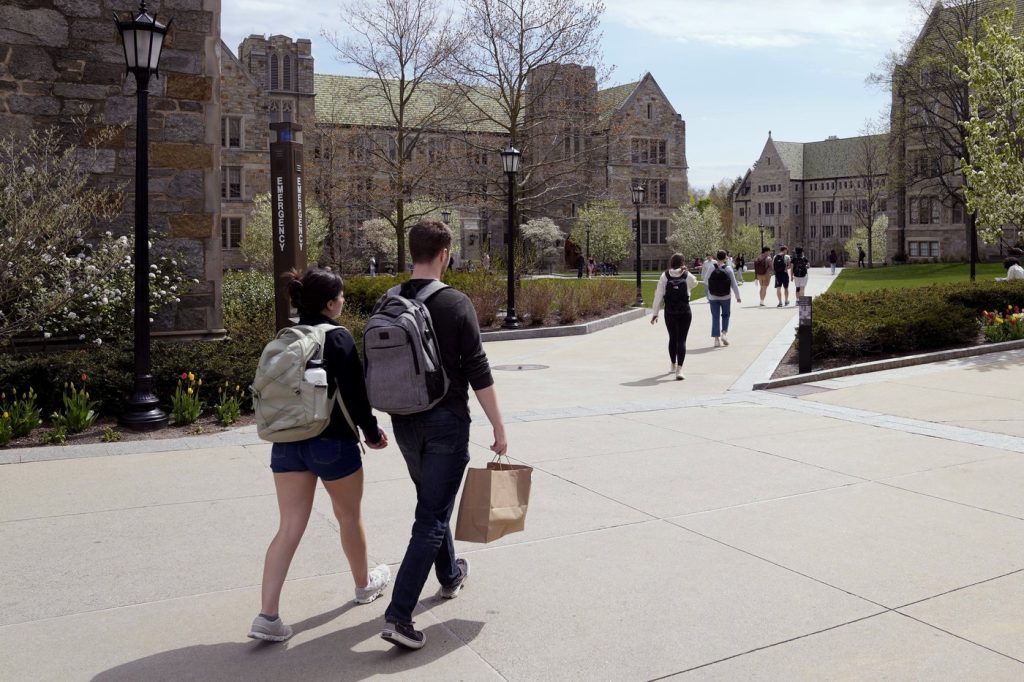BOSTON (AP) – Recent research indicates that the cost of attending college, particularly at public universities, has decreased significantly over the past decade. Contrary to the ongoing narrative that college fees are constantly rising, data from the nonprofit College Board reveals that students are paying considerably less for their education than they did ten years ago.
This year, the average tuition for students attending in-state public universities is $11,610, marking a 4% decline when adjusted for inflation compared to a decade ago. When considering grants and financial aid, the net cost for students has seen a more substantial reduction, dropping by 40% from $4,140 to $2,480 annually.
The decrease in tuition costs has led to a reduction in student borrowing. Currently, just under 50% of students attending in-state public universities graduate with some form of debt, a decrease from 59% a decade ago. Among borrowers, the average loan balance has also decreased by 17%, now standing at $27,100.
Meanwhile, tuition at private colleges continues to rise, but at a markedly slower pace. Over the last decade, costs have increased by only 4% when factoring in inflation, reaching an average of $43,350. This stands in stark contrast to the previous two decades, during which tuition surged by 68%.
The downward trend in college costs has coincided with a growing skepticism among Americans regarding the value of a college degree. Surveys show that fewer high school graduates are pursuing higher education, with statistics from the U.S. Bureau of Labor Statistics indicating a downturn in college enrollment rates not seen in decades.
Despite these concerns, research conducted by Georgetown University’s Center on Education and the Workforce indicates that a bachelor's degree still offers a significant return on investment. Graduates earn a median of $2.8 million over their careers, approximately 75% more than those who only possess a high school diploma.
The COVID-19 pandemic has been a crucial factor in reducing college costs. According to Jennifer Ma, an executive research scientist at the College Board, many institutions implemented tuition freezes during the pandemic. Furthermore, increased funding from state and federal sources enabled colleges to lower the cost of attendance, although some of this financial support has diminished since the peak of the pandemic.
For example, Kai Mattinson, a senior at Northern Arizona University, indicated cost was a primary consideration in her choice of university. While tuition was initially projected to be around $39,000 annually, scholarships and discounts reduced her cost to between $15,000 and $20,000. Mattinson noted, "I originally wanted to go to the University of Arizona, but when it came down to tuition and other costs, Northern Arizona University was the best option."
Many institutions are actively managing tuition increases. Purdue University, for example, has maintained its annual in-state tuition at $9,992 for the past 13 years. Mark Becker, the president of the Association of Public and Land-grant Universities, expressed optimism about these developments, attributing increased college affordability to institutional cost control, along with state and federal investments.
The trend is even more pronounced for public two-year community colleges, where costs have decreased by 9% over the last decade. However, the high costs associated with out-of-state public universities and private colleges remain a significant hurdle for many families, with expenses sometimes reaching up to $95,000 per year. Nevertheless, many institutions provide substantial financial aid to middle- and lower-income students.
Private colleges are also enhancing their financial aid offerings. The Massachusetts Institute of Technology recently announced that undergraduate students from families earning less than $200,000 would not be required to pay any tuition starting in the fall. Additionally, various private colleges are reducing tuition costs as part of strategic efforts to attract students in an increasingly competitive landscape.
In conclusion, colleges face challenges stemming from a dwindling pool of young adults considering higher education, alongside rising operational costs. As institutions attempt to navigate these turbulent waters and attract prospective students, many resort to cutting programs and implementing financial strategies to keep costs manageable.










